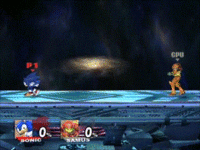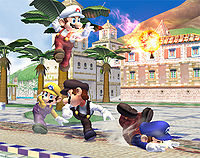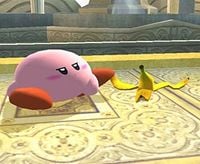Tripping
Tripping (officially called prat falling; referred to in game files as slipping) is a gameplay mechanic introduced in Super Smash Bros. Brawl in which a fighter trips, falls over, and sits in a prone state with a confused expression. Whenever a character begins to dash or, while running, turn, or performs any button input that involves tapping the control stick (most notably those of a forward smash or side special move), there is a 1% chance that they will trip; certain attacks and items will also cause tripping. Brawl keeps track of the total number of Prat Falls each character or name has experienced in Group Brawls.
The sound effect for tripping changes depending on whether the character tripping is from a 'cartoonish' or 'realistic' game/series. Characters from more serious or 'realistic' franchises make make a light, quick whoosh sound, followed by an unimpressive falling-down noise, while more cartoonish characters (that is, most of the cast) make a swabbing noise like a sliding mop before landing with a distinctive timpani noise.
When sitting down, a character has the same options as when lying down; however, a tripped character is more vulnerable. Unlike prone fighters, sitting fighters can be grabbed; attacks from a sitting position are weaker than from a lying down position, usually dealing 5% as opposed to 6%, lacking transcendent priority, and possessing only 8 safe frames (attacking while lying down usually keeps the character safe until the attack's hitboxes end); and rolls and stand ups are generally subpar to their lying down counterparts, possessing fewer invincibility frames yet comparably long animations.
In Super Smash Bros. 4, random tripping no longer occurs, and only certain hitboxes will cause tripping.
Causes of tripping in Brawl

- Whenever the control stick is smashed left or right, whether from inputting a dash or an attack, there is a 1% chance for the player to trip.
- Surfaces with a lack of traction, namely ice, have a higher likelihood of causing tripping.
- Certain attacks have chances of tripping the opponent when they hit (several down tilts and other weaker attacks that hit low to the ground are designed to trip opponents).
- If an attack hits a target at a low angle (such as the Sakurai angle) and the target does not leave the ground from the knockback, there is an additional chance to trip.
- Being hit by/stepping on a Banana Peel causes tripping.
- When Tingle rains down banana peels (note that these are 2D sprites, not actual Banana Peels), it causes constant tripping to all opponents until he leaves the screen.
- Luigi's Negative Zone can cause incessant tripping.
List of tripping attacks in Brawl
Most attacks can only make an opponent trip if the target is not already sitting down and the attack knockback does not knock the target into the air. However, some have the slip effect and will therefore result in a trip regardless of these circumstances; these are represented in this list with "Always".
| Attack | Trip chance | |
|---|---|---|
| Bowser | Forward tilt (angled down) | 40% |
| Down tilt | 30% | |
| Giga Bowser | Forward tilt (angled side) | 50% |
| Forward tilt (angled down) | 100% | |
| Up tilt | 50% | |
| Captain Falcon | Down tilt | 50% |
| Forward air (sour spot) | 30% | |
| Diddy Kong | Banana Peel | Always |
| Donkey Kong | Forward tilt (angled down) | 15% |
| Down tilt | 40% | |
| Falco | Down tilt | 40% |
| Down smash | 40% | |
| Reflector | 40% | |
| Fox | Down tilt | 40% |
| Down smash | 35% | |
| Ganondorf | Down tilt | 35% |
| King Dedede | Neutral attack (hit 2) | 20% |
| Down tilt | 40% | |
| Back aerial | 30% | |
| Kirby | Down tilt | 35% (foot) 30% (toe) |
| Link | Down tilt | 40% |
| Down smash | 30% | |
| Lucas | Down tilt (foot) | 40% |
| Down smash | 40% | |
| Luigi | Down tilt | 35% |
| Dash attack (last hit) | 30% | |
| Negative Zone | Unknown | |
| Mario | Down tilt | 40% |
| Cape | 30% | |
| Meta Knight | Down tilt | 30% |
| Mr. Game & Watch | Judge #2 | 20% |
| Ness | Down tilt | 30% |
| Peach | Down tilt | 30% |
| Down smash | 20% | |
| Pikachu | Neutral attack | 10% |
| Down tilt | 30% | |
| Down smash (last hit) | 30% | |
| Skull Bash | 30% | |
| Samus | Down tilt | 40% |
| Down smash | 30% | |
| Sheik | Down tilt | 40% |
| Down smash | 40% (hit 1) 30% (hits 2-3) | |
| Toon Link | Down tilt | 40% |
| Dash attack | 30% | |
| Down smash | 30% | |
| Neutral air | 30% | |
| Wario | Down tilt | 40% |
| Down smash (before frame 32) | 30% | |
| Wario Waft (uncharged) | Always | |
| Wolf | Down tilt | 40% |
| Forward smash (rear segment) | 60% | |
| Down smash | 35% | |
| Up air | 35% | |
| Blaster | 40% (claw front) 37% (claw back) | |
| Yoshi | Down tilt (clean) | 30% |
| Down tilt (tip) | 40% | |
| Zelda | Down tilt | 40% |
| Down smash | 30% | |
| Zero Suit Samus | Forward tilt | 20% (angled side) 60% (angled down) |
| Down tilt | 40% | |
| Down smash | 30% | |
| Items | Banana Peel | Always |
| Fan neutral | 10% | |
| Fan tilt | 20% | |
| Fan smash | 30% | |
*Copy abilities not mentioned are the same as their originals.
Controversy
Random tripping is arguably the most disliked addition to Brawl and is generally panned by casual players and universally panned by competitive players. Though it is generally perceived as an annoyance, random tripping has large potential to impact a match. Since tripping leaves the player in a significant state of vulnerability while moving them a small distance forward, it is a common occurrence for players to unintentionally trip into an otherwise avoided attack, which can be as minor as a one-hit inconsequential punish (or, on the part of the tripping fighter, a missed opportunity to punish) or as major as a premature KO and even loss of the match. Though it is rare, random tripping also makes it slightly more difficult to read an opponent; a fighter may read an opponents action and input a punish, but instead, the opponent trips, keeping them out of the reach of the attack.
Many players have cited random tripping as an unnecessary and detrimental addition to the game, since, in their view, it not only adds nothing worthwhile to the game, but introduces a constant element of chance that disrupts gameplay and has the potential to decide a match. Random tripping is also said to harm the metagame of Brawl; it cannot be used as part of any strategy since it is impossible to predict consistently enough.
Random tripping is usually removed in fan-made edits of Brawl, with the four major Brawl mods - Brawl+, Brawl Minus, Balanced Brawl, and Project M - each removing it, though forced tripping from items and attack are retained in each.
While random tripping is considered a detriment to tournament play, forced tripping is seen as acceptable and is looked upon much more favorably, since, unlike random tripping, it is not interruptive and can be predicted and used. As such, forced tripping is an integral part of some characters' metagames, especially Diddy Kong and his Banana Peels, and is among the strongest reasons for his top-tier placement.
Trivia
- Masahiro Sakurai, the lead developer of Brawl, is commonly thought to have added random tripping into the game, for which he has become somewhat infamous; as a result, references to Sakurai are commonly made when a trip results in significant consequences in tournament.
- The Super Smash Bros. Melee bonus, Pratfaller, does not have anything to do with Brawl's "prat falling". Instead, it is awarded if a character always lands face up after tumbling.
- If a Fighting Alloy is hacked into a normal match and loses, their losing animation is their sitting pose.
- Tripping was first discovered during the Brawl demo at E for All. It was not recognized as random at the time, and some players tried to learn how to trigger it at will for use as a technique. For a time it was known as Ink Dropping, as noted in Gimpyfish's famous SWF thread.
- Oddly enough, in Super Smash Bros. 4, Pit and Dark Pit make the 'cartoonish' tripping noise while Palutena makes the 'realistic' one, despite the fact that all three characters are from the same series and have similar aesthetics. Similarly, Toon Link is the only Legend of Zelda character to make the 'cartoonish' noise, but this is justified because of his being based on the cartoonish Wind Waker aesthetics rather than the more realistic Twilight Princess ones used by the other characters.


